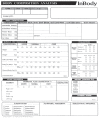Effects of aerobic exercise on plasma lipoproteins in overweight and obese women with polycystic ovary syndrome
- PMID: 25878993
- PMCID: PMC4386212
- DOI: 10.4103/2277-9175.153892
Effects of aerobic exercise on plasma lipoproteins in overweight and obese women with polycystic ovary syndrome
Abstract
Background: Polycystic ovary syndrome (PCOS) is one of the most frequent endocrine disorders. The PCOS manifest by hyperandrogenism, hypertension and cholesterol and lipoprotein improper profiles. Changing the life style, e.g. increasing physical activities is the first approach in controlling PCOS.
Materials and methods: Twenty-four women affected by polycystic ovary syndrome (PCOS) after medical screening were divided in to two groups: Experimental group (n = 12) and control group (n = 12), with the average age, weight, height, BMI and WHR of 26.87 ± 4.43 years, 75.71 ± 10.65 kg. 159.29 ± 6.44 cm, 29.86 ± 3.22 kg/m(2) and 91.75 ± 5.86 respectively. First the body composition such as BMI, WHR, percent body fat, weight and body fat mass were measured. In fasting blood samples the level of HDL, LDL, VLDL, triglyceride and cholesterol were measured. Then the experiment group underwent the effect of an aerobic exercise program. After 12 weeks, all the measured variables before intervention the test were re-measured. Correlated t-test was used for comparing the two groups before and after intervention the test and independent t-test was used for comparing the two groups (P < 0.05).
Results: The results showed that after 12 weeks of exercise, BMI, WHR, fat rate, weight and fat mass and triglyceride had significant reduction and HDL had significant increase. But no significant changes happened in LDL, VLDL, and cholesterol levels.
Conclusion: Reducing the weight by aerobic exercise in obese women and affected by PCOS can correct lipoprotein profile and improving health.
Keywords: Aerobic sport; body compositions; plasma lipoproteins; polycystic ovary syndrome.
Conflict of interest statement
Figures
Similar articles
-
Serum lipoprotein lipid profile in women with the polycystic ovary syndrome: relation to anthropometric, endocrine and metabolic variables.Clin Endocrinol (Oxf). 1994 Oct;41(4):463-71. doi: 10.1111/j.1365-2265.1994.tb02577.x. Clin Endocrinol (Oxf). 1994. PMID: 7955457
-
Lipids and lipoprotein subfractions in women with PCOS: relationship to metabolic and endocrine parameters.Clin Endocrinol (Oxf). 2001 Apr;54(4):447-53. doi: 10.1046/j.1365-2265.2001.01228.x. Clin Endocrinol (Oxf). 2001. PMID: 11318779
-
Altered composition of high density lipoproteins in women with the polycystic ovary syndrome.J Clin Endocrinol Metab. 1997 Oct;82(10):3389-94. doi: 10.1210/jcem.82.10.4318. J Clin Endocrinol Metab. 1997. PMID: 9329374
-
[Body composition and polycystic ovary syndrome].Medicina (Kaunas). 2010;46(2):142-57. Medicina (Kaunas). 2010. PMID: 20440089 Review. Lithuanian.
-
Metabolic effect of obesity on polycystic ovary syndrome in adolescents: a meta-analysis.J Obstet Gynaecol. 2017 Nov;37(8):1036-1047. doi: 10.1080/01443615.2017.1318840. Epub 2017 Jun 28. J Obstet Gynaecol. 2017. PMID: 28657375 Review.
Cited by
-
Modulation of hormonal, metabolic, inflammatory and oxidative stress biomarkers in women with polycystic ovary syndrome following combined (resistant and endurance) training: a randomized controlled trail.BMC Endocr Disord. 2025 Jan 2;25(1):1. doi: 10.1186/s12902-024-01793-0. BMC Endocr Disord. 2025. PMID: 39748376 Free PMC article. Clinical Trial.
-
The effect of exercise as an intervention for women with polycystic ovary syndrome: A systematic review and meta-analysis.Medicine (Baltimore). 2020 Apr;99(16):e19644. doi: 10.1097/MD.0000000000019644. Medicine (Baltimore). 2020. PMID: 32311937 Free PMC article.
-
Effect of 12-week of aerobic exercise on hormones and lipid profile status in adolescent girls with polycystic ovary syndrome: A study during COVID-19.Sci Sports. 2023 Apr 4. doi: 10.1016/j.scispo.2022.11.001. Online ahead of print. Sci Sports. 2023. PMID: 37362083 Free PMC article.
-
Exercise and reproductive function in polycystic ovary syndrome: protocol of a systematic review.Syst Rev. 2017 Dec 22;6(1):264. doi: 10.1186/s13643-017-0666-5. Syst Rev. 2017. PMID: 29273090 Free PMC article.
-
The feasibility of progressive resistance training in women with polycystic ovary syndrome: a pilot randomized controlled trial.BMC Sports Sci Med Rehabil. 2016 May 11;8:14. doi: 10.1186/s13102-016-0039-8. eCollection 2016. BMC Sports Sci Med Rehabil. 2016. PMID: 27175282 Free PMC article.
References
-
- Harrison CL, Lombard CB, Moran LJ, Teede HJ. Exercise therapy in polycystic ovary syndrome: A systematic review. Hum Reprod Update. 2011;17:171–8. - PubMed
-
- Hirschberg AL. Polycystic ovary syndrome, obesity and reproductive implications. Womens Health (Lond Engl) 2009;5:529–40. - PubMed
-
- Speroffl MF. 7th ed. Philadelphia: Lippincott Williams and Williams; 2005. Clinical gynecology endocrinology and infertility; p. 465.
-
- Pasquali R, Casimirri F, Ralestra V, Flamia R, Melchionda N, Fabbri R, et al. The relative contribution of androgens and insulin in determining abdominal fat distribution inpremenopausal women. J Endo Crinol Invest. 1991;14:839. - PubMed
-
- Hoeger KM. Exercise Therapy in Polycystic Ovary Syndrome. Semin Reprod Med. 2008;26:93–100. - PubMed
LinkOut - more resources
Full Text Sources
Other Literature Sources
Medical


